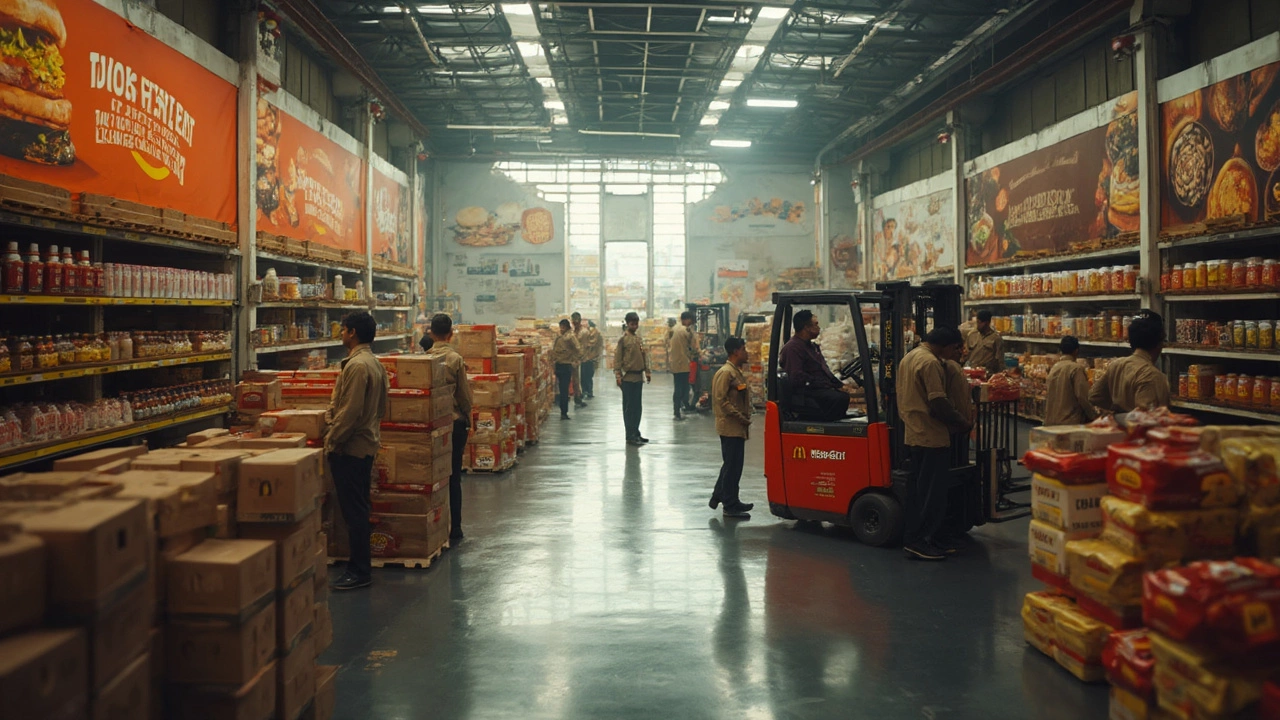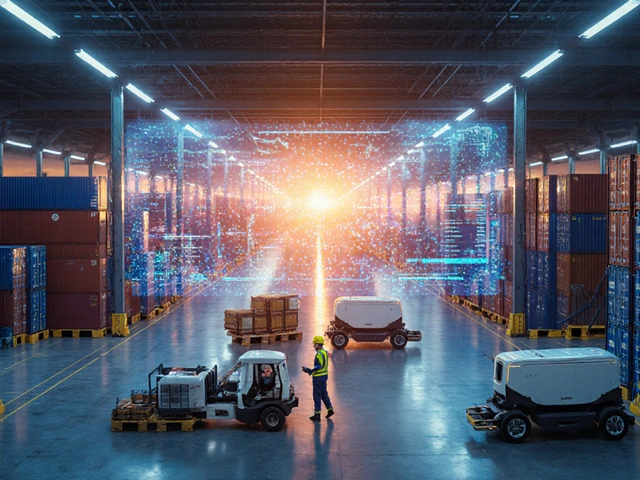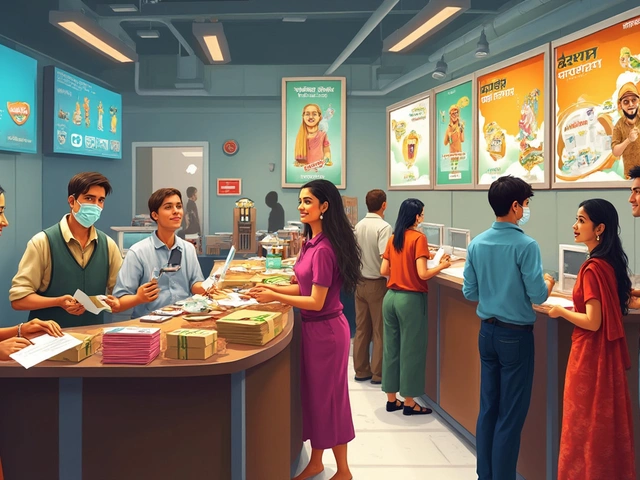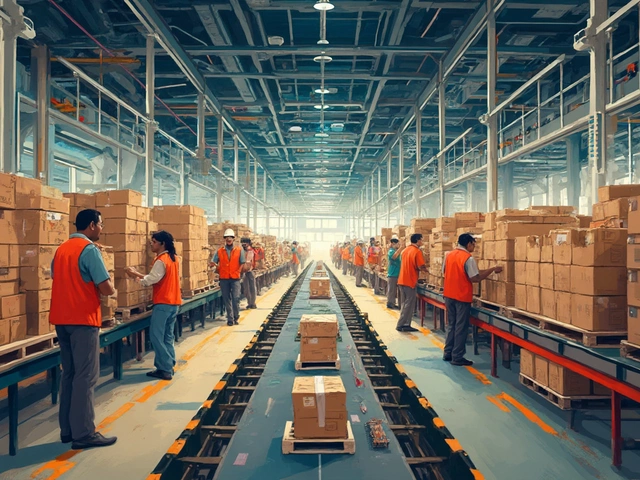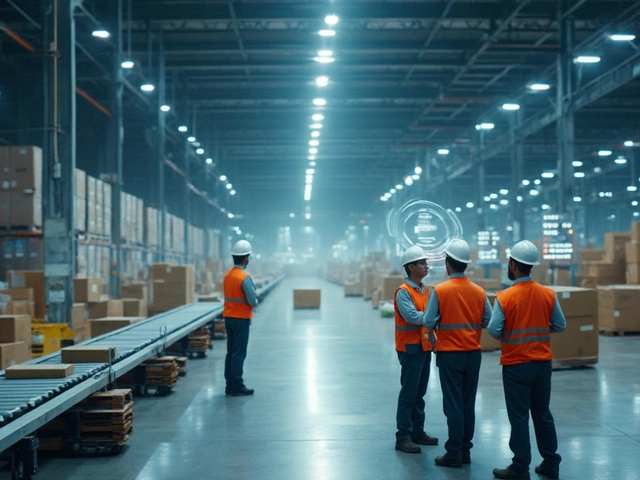Think about how fast your order lands on the counter at McDonald's. Fries crispy, nuggets piping hot, burgers never running out—ever stopped to wonder how they pull that off? It doesn’t just happen by magic or luck. There’s a serious system humming in the background, way before you sink your teeth into a Quarter Pounder.
Here’s the real deal: yes, McDonald's uses warehouses. But they're way more than just big rooms stuffed with boxes. Their warehouses are link-up points in a tightly managed supply chain, helping store, sort, and move everything from frozen fries to buns to sauces. Every item you munch on has pretty much vacationed in a warehouse—or what the industry calls a distribution center—before hitting your tray. And it's not just about storage. It’s about timing and freshness—making sure nothing is too early, too late, or too old to serve. Without these warehouse centers, you’d see a lot more empty fryers and disappointed kids (including mine, Emery, who refuses to forgive a nugget shortage).
- How McDonald's Supply Chain Stays Fast
- The Role of Warehouses in Food Delivery
- Where Your McNuggets Wait Before Cooking
- Why Consistency Needs Smart Storage
- Global vs. Local Distribution Tricks
- Lessons from McDonald’s for Your Warehouse
How McDonald's Supply Chain Stays Fast
Speed isn’t just a McDonald’s trademark for serving customers—it’s wired into their entire supply system. Imagine having to deliver millions of burgers, fries, and shakes every day, across thousands of locations, and almost never missing a beat. That’s the kind of hustle we’re talking about.
The backbone here? A seriously slick network of distribution centers. In the U.S. alone, McDonald’s taps into more than 20 dedicated warehouse partners, like Martin Brower, which runs big climate-controlled hubs from coast to coast. These centers pull in products from farmers, meat processors, and bakeries, then send them out in a precise rhythm based on each restaurant’s sales and weather (yes, they factor in heatwaves and football games).
- Deliveries usually happen two to three times per week to every restaurant.
- Stock is rotated fast, so food doesn’t get old sitting in storage.
- Each warehouse tracks sales data to predict what the stores will need next week—and adjust shipments on the fly.
By keeping things local, they cut down on costs and delays. If a Chicago restaurant is running low on fries, it isn’t waiting for a truck from Texas. Instead, it’s usually just hours away from a refilled freezer thanks to a nearby warehouse.
Here’s a quick look at how big the operation is:
| Stat | Number |
|---|---|
| U.S. McDonald's restaurants | ~13,500 |
| Annual supply deliveries | Over 5 million |
| Main U.S. distribution partners | 3 (Martin Brower, McLane, Reinhart) |
Keeping that kind of engine moving is why McDonald’s supply chain often gets called a gold standard in the fast food business. Their ability to stay fast, fresh, and reliable is all about the mix of smart warehouse strategy, regular deliveries, and some serious data crunching on what customers want.
If you’ve ever wondered why your order is ready within minutes, or how McDonald’s never seems to run out of the basics, well—this turbocharged, warehouse-powered supply chain is the secret sauce.
The Role of Warehouses in Food Delivery
Ever wonder where those burger buns and fries hang out before they show up on your tray? The answer: in warehouses designed just for food delivery. For a giant like McDonald’s, warehouses are like the heart of their supply chain. These places keep everything organized, cold (or frozen, depending on what’s inside), and safe to eat. No warehouse, no way to handle the insane amount of demand from thousands of locations across the country.
McDonald’s doesn’t own all the warehouses it uses. Most of the heavy lifting happens through partnerships with big-name distributors like Martin Brower. These are massive companies that specialize in gathering food from suppliers, storing it under tight temperature control, and trucking it out to restaurants fresh. Warehouse teams stick to a tight schedule because food quality drops fast if you mess up timing or temperatures. Imagine a truckload of thawed-out nuggets—that’s a disaster for hungry customers and McDonald’s reputation.
Temperature is everything. McDonald's warehouses split food into zones: frozen, refrigerated, and dry goods. Here’s a quick look at how each area stacks up when it comes to keeping food safe and tasty:
| Zone | Typical Temp (°F) | What’s Stored |
|---|---|---|
| Frozen | 0° or lower | Beef patties, fries, chicken nuggets |
| Refrigerated | 34–38° | Dairy, lettuce, sauces |
| Dry | Room temperature | Buns, napkins, ketchup packets |
These warehouse hubs don’t just store stuff. Their teams break down big shipments from suppliers, repack orders by restaurant, and keep a digital eye on freshness dates. McDonald's has warehouse tech tracking shelf life so nothing old slips through. They use automatic alerts and regular checks to spot problems before they can cause trouble.
So if you’ve ever complained about a cold burger or soggy fries, odds are, it wasn’t a warehouse issue. These guys are pros at getting food from field to fryer fast and safe. Want to keep a restaurant chain running without hiccups? Warehouses are one piece of the puzzle you can't skip.
Where Your McNuggets Wait Before Cooking
Your McNuggets’ journey isn’t some mystery—they take a road trip most folks never see. Before those nuggets end up sizzling in oil, they’re chilling (literally) in state-of-the-art freezer sections inside large McDonald's distribution centers. These aren’t your backyard freezers—most are massive, climate-controlled rooms that keep everything frozen solid until it’s go-time for delivery.
So how does this work in real life? Nuggets get made at approved suppliers, go through quality checks (like, making sure every bite looks and tastes the same), and then get packed in special cases designed for long-haul transport. The warehouse teams play a key part—they monitor temperature 24/7, check stock lots constantly, and make sure nothing gets old sitting at the back. Automatic systems track which goods came in when, so older stuff leaves first (it’s called FIFO—first in, first out).
Here’s what usually happens between the factory and the fryer at your local store:
- Suppliers make and freeze the nuggets to lock in flavor and freshness.
- Frozen McNuggets ship out to regional warehouses, kept at -18°C (about 0°F) or colder.
- Warehouses use tight scheduling—most don’t hold stock for more than a few days to a week.
- Local restaurants get regular deliveries, sometimes up to three times a week, based on demand.
Ever wondered just how much food moves through these facilities? Check this out:
| Warehouse Fact | Typical Number |
|---|---|
| Average warehouse size (sq. ft.) | 75,000 – 250,000 |
| Holding temperature for nuggets (°C) | -18 |
| Boxes moved per day (global avg.) | Over 15 million |
What does that mean for you? Those nuggets in your Happy Meal were probably frozen and zipped from a warehouse just a few days ago, not lost in storage for months. This tight loop keeps everything safe, keeps tastes the same in Tokyo or Toronto, and avoids waste or spoilage. Good news for anyone who likes a late-night snack—you know exactly where those nuggets waited before the fryer did its thing.

Why Consistency Needs Smart Storage
You ever wondered why a Big Mac tastes the same whether you’re in Chicago, London, or Tokyo? It’s not a lucky accident. The real hero here is smart storage, and McDonald’s runs it like a science experiment. Every ingredient stays in carefully managed conditions until it's shipped out, keeping quality and flavor on point.
First off, the McDonald's supply chain uses what’s called cold chain logistics. That means products like burger patties, cheese, and fries stay frozen or chilled from warehouse to restaurant. These warehouses use tech to monitor temperature and humidity every minute—if those dip or spike, alarms go off and fixes happen fast. No one wants soggy fries or wilted lettuce.
Every box—from ketchup to chicken—has labels for tracking and expiration dates. Warehouse workers scan these in and out, so nothing sneaks past its prime. If you want to keep things fresh, you’ve got to move older stock first (what they call FIFO: first-in, first-out). Sounds simple, but try doing it for thousands of boxes each day and you’ll see why they use automated systems and barcode scanners to help staff pick the right stuff.
Here’s where it gets interesting: McDonald’s doesn’t just store stuff and cross its fingers. Their storage is set up by menu demand. If the McRib is coming back for a limited time, storage shifts to handle extra pork and sauces. If Lent is around the corner, they crank up on Filet-O-Fish supplies. Warehouses flex to match what customers want when they want it. Nothing random, all planned.
All these steps mean no surprises for the customer. Want to keep your own warehouse running sharp like McDonald’s? Key moves include:
- Keep storage areas sorted by product type and temperature needs
- Use tracking and automated alerts for freshness and expiration
- Always shift older stock out first so nothing spoils
- Be ready to shift storage needs as demand changes
That’s the lowdown. Consistency on every tray starts with storage that’s organized, tech-driven, and tailored for what’s inside. It’s not glamorous, but without it, McDonald’s wouldn’t have that famous, predictable taste no matter where you order.
Global vs. Local Distribution Tricks
McDonald’s runs more than 40,000 restaurants across 100+ countries. Think about the challenge: you have to get the exact same fries, burgers, and McNuggets to everyone, no matter where they are—from a main street in Tokyo to a remote spot in rural Texas. That’s where their well-oiled mix of global and local distribution shines.
Globally, McDonald’s hooks up with big-name food producers—think of companies like Tyson Foods for chicken, McCain for fries, and Coca-Cola for drinks. These major players ship truckloads to the regional warehouses, which hold everything in the right conditions—cold for meats, dry for buns, separate for sauces. So the core taste stays the same, no matter the country.
But here’s the clever part: McDonald’s also goes local. They adapt menus and source some produce from local partners to cut down delivery times, lower costs, and keep things fresh. For example, in India, they’ll use local cheese and farmers, while in the UK they lean on British potatoes. This dual strategy smooths out hiccups when shipping gets tricky or when countries want regional flavors.
Here’s how the McDonald's warehouse network keeps things moving:
- Goods are shipped from global suppliers to centralized regional warehouses (often called distribution centers).
- Distribution centers break down huge shipments into smaller, store-ready deliveries.
- Special trucks—chilled, frozen, or regular—leave these centers almost daily for each restaurant.
- Local products get added in at the warehouse, mixing global staples with hometown favorites.
Check out some real numbers to see their scale:
| Region | Number of Distribution Centers | Average Weekly Deliveries per Store |
|---|---|---|
| USA | 77 | 3-5 |
| Europe | Nearly 60 | 2-3 |
| Asia-Pacific | 35+ | 2-4 |
So next time you see those perfect fries, remember: it’s not luck, it’s a battle-tested system blending global supply muscle with smart local moves, all powered by fast-flowing warehouses.
Lessons from McDonald’s for Your Warehouse
So what can you learn from the way McDonald’s runs its storage operations? More than you might think. Their supply chain is a masterclass in getting stuff to the right place, at the right time, in the right condition. Whether you’re dealing with food, retail goods, or electronics, there are a few moves you can borrow from their playbook.
First off, McDonald’s supply chain relies on serious coordination between suppliers, warehouses, and restaurants. They don’t just stash food in random spots and hope for the best—every delivery and storage step is planned to the minute. If you run a warehouse, look into setting up tight delivery schedules and real-time tracking. Lost or late shipments aren’t just annoying—they actually mess with product quality and customer trust.
Another trick: McDonald’s warehouses use temperature zones. Frozen fries and patties sit in deep freezers, while lettuce and veggies chill at slightly warmer temps. Even sauces and condiments have their own storage rules. If your business handles stuff with different storage needs, dividing your space by temperature or product type can cut down on waste and spoilage big-time.
It’s also all about inventory control. McDonald’s is famous for its “just-in-time” inventory system. They don’t want stuff gathering dust or going stale. Adopting tighter inventory management—like using digital tracking or automated alerts when stock runs low—can help you avoid the dreaded out-of-stock or overstock issues.
- Set up digital systems for inventory checks instead of manual ones.
- Create sections in your warehouse for different climate needs.
- Work closely with your suppliers to anticipate demand shifts, just like McDonald’s does for special promotions or new menu items.
- Review delivery and receiving schedules—be picky about timing to keep products fresh and customers happy.
One more move straight from the McDonald's playbook: train your team. Every person in their supply chain knows exactly what’s expected—no confusion, no mix-ups. Make sure your warehouse crew gets clear instructions and ongoing training, especially if you change up processes or bring in new tech.
Copying these tips won’t turn you into a fast-food giant overnight, but it can make your warehouse smoother, more reliable, and a lot less stressful to run. Just remember, whether you’re serving fries or furniture, top-notch logistics always pay off.
